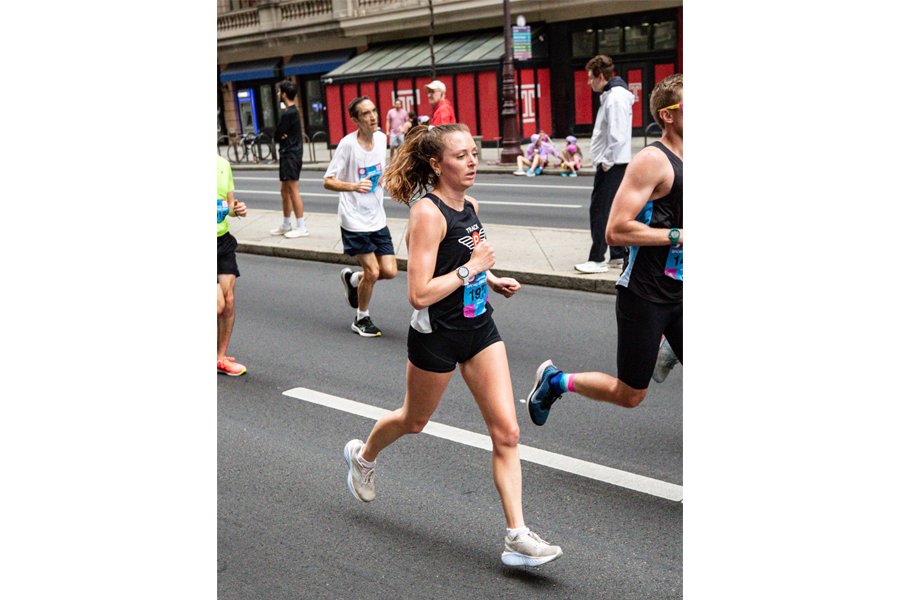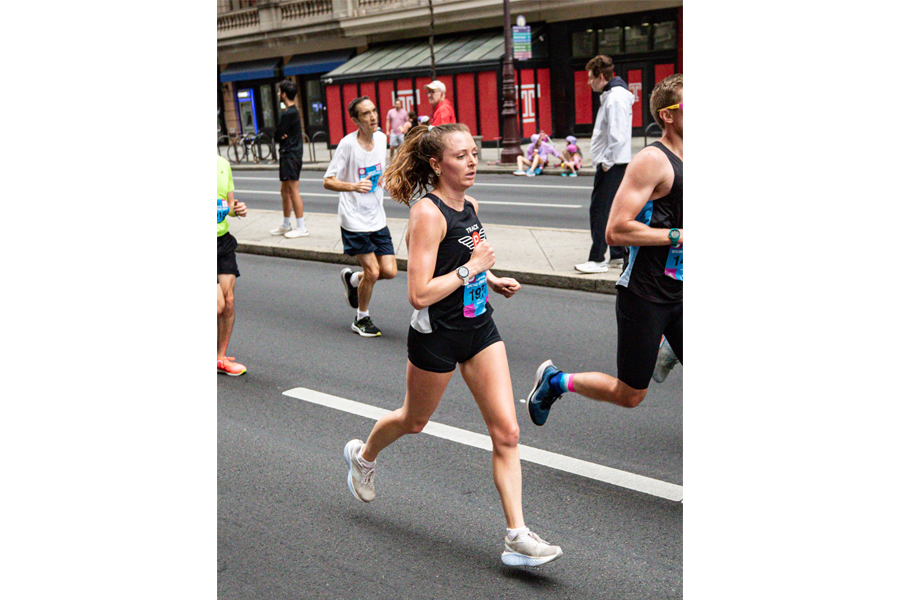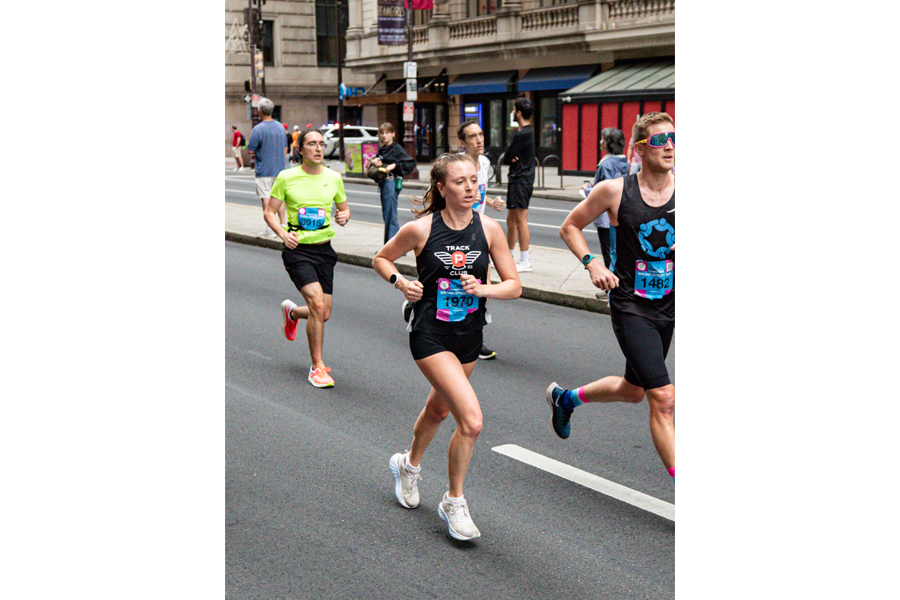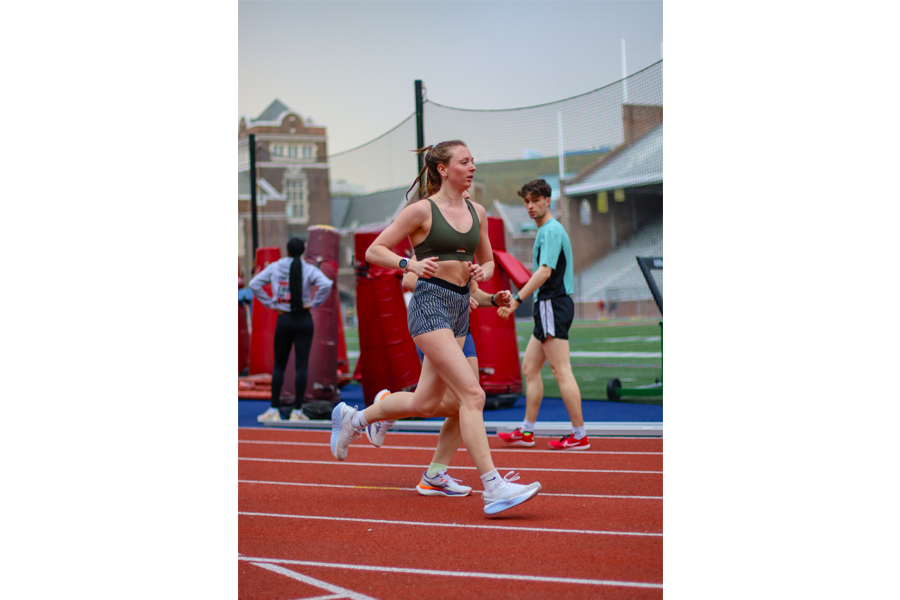Can you imagine finishing the Broad Street Run in 66 minutes? Even for most competitive athletes, it would be a pipe dream.
But that’s exactly what Brynn Peterson achieved in this year’s race—less than a year after Temple Health-Chestnut Hill Hospital physicians discovered nearly 30 blood clots in her lungs.
“In October of 2024, when I was training for the Philadelphia Marathon, I started feeling really lethargic and experiencing a lot of chest pain,” explains the 24-year-old Peterson, a local teacher who ran track and cross-country for LaSalle, and is a member of Philadelphia Runner Track Club’s sub-elite team. “It was difficult for me to even get out of bed and walk to the bathroom.”
“A lot of my teammates are healthcare professionals, and they recommended I go to the doctor and get things checked out,” Peterson says. “I went to the Chestnut Hill Hospital Emergency Department, and the bloodwork they did showed that I had the troponin levels of an 80-year-old woman, and that my heart was severely distressed. The doctors decided to do a CT scan, which showed that I had 20-30 pulmonary embolisms in my lungs.”
“One of the blood clots had been dislodged so that it was cutting off the blood flow to my right lung, to the point that it was a partially dead lung,” she continues. “That was why I was experiencing some of that chest pain when breathing: because the tissue was flaking off the dead lung.”
Overcoming Hurdle after Hurdle
Peterson was put on blood thinners immediately, and, after a four-day stay in the hospital, was on bedrest for the next two weeks. She had to cancel her plans to run the Philadelphia Marathon—which, at that point, was only a week away.
In the meantime, doctors focused on identifying the cause of her blood clots, which they believed had been developing for about two months. After testing, they found that she has the prothrombin gene mutation, which significantly increases blood clot risk. Another factor? During marathon training, Peterson had become dehydrated, which can thicken blood and constrict blood vessels.
“When I got the diagnosis, the doctors told me, ‘We don’t know exactly when or if you’ll be able to get back into running,’” Peterson says. “They said it would depend on how long my body would take to get over the blood clots, and any heart damage or strain I experienced.”
After 10 days, she was allowed to walk, but only if her heart rate stayed below 100 bpm. “After a month, I was allowed to swim, because that doesn’t put pressure on your joints,” continues Peterson, who was also on the swim team at LaSalle. After three months, she started running again—but because the blood thinners had weakened her bones and joints, she almost immediately suffered a sprained ankle.
“That took me out for a good three to four months, so I could only get back into running about a month before the Broad Street Run,” Peterson says.
Yes, you read that correctly: coming off of 20-30 pulmonary embolisms, a partially dead lung, and a sprained ankle, Peterson was still planning to tackle the Broad Street Run with about 30 days of training. (It’s also why multiple media outlets, like CBS News Philadelphia and PhillyVoice, covered her journey.)
But she wasn’t being reckless: her pulmonologist, Parth M. Rali, MD, FCCP, Associate Professor of Thoracic Medicine and Surgery at the Lewis Katz School of Medicine and Director of the Pulmonary Embolism Response Team at Temple University Hospital, was closely monitoring her recovery.
“When I saw Dr. Rali in March, he said, ‘I think you can start running again. You don’t have any more blood clots, and your ankle’s healed,’” Peterson shares. “He was definitely very impressed with how fast my body recovered, but I just think that’s because of how active I’ve been in my life.”
“I Did It. I Got Myself Back”
Once she got the go-ahead from Dr. Rali, Peterson didn’t waste a minute. “I went back to my training plan with my team, which meant I started out running 30 miles a week,” she explains. “I’d already been cross-training, which meant I had that base. And then I built it up, week-by-week, until I got to about 50 miles, and kept holding at that point.”
Peterson’s goal was to finish the Broad Street Run in 66 minutes—and, wearing her elite bib, she made that time.
“I thought I would be more emotional when I crossed the finish line, but since I was really racing, I was just so tired,” she laughs. “It really hit me when I was at home alone and looked at my medal and just gave myself a second. I had signed up for the Broad Street Run in February, before my ankle sprain happened and I got all of my encouraging blood tests back. At that point, I really didn’t think I was going to be running it.”
“Because I’m such an athlete, after the race, I had been thinking, ‘Oh, my time was fine: I met my goal, but it wasn’t under what I wanted,’” she continues. “But when I saw the medal, I thought, ‘To heck with that. I did it. I got myself back.’”
“A Lifelong Journey”
Unsurprisingly, Peterson isn’t planning on stopping at the Broad Street Run. She’s aiming for a half marathon this summer, and wants to tackle the Philadelphia Marathon in November.
Dr. Rali, her pulmonologist—himself an avid runner—is behind her all the way. “Patients like Brynn are on a lifelong journey and will continue to be monitored, but I’m very happy with her progress,” he says. “The fact that last November, she was in my clinic with dozens of blood clots, and this May, she did the Broad Street Run, is a perfect example of recovery.”
“Because we have Temple Lung Center physicians like William B. Shapiro, MD as the primary pulmonologists at Chestnut Hill Hospital, Brynn was able to have her blood clots addressed and cared for at the highest level, close to home,” Dr. Rali continues. “This is exactly how Temple Health’s integration benefits our patients.”
Peterson also appreciates her care team’s focus on creating a safe and individualized recovery plan. “They set up a plan that was realistic for an athlete: in which I could walk and move my body, because they knew that was something I wanted,” she says. “Having Dr. Rali, who’s a runner himself, was great: he could understand how much I wanted to get back into it.”
“He was also very helpful in answering the questions I had, especially around when to go to the hospital,” Peterson continues. “After you have a blood clot, there’s a lot of trauma; every time you have chest pain or a headache, you automatically jump to the worst-case scenario. There were a lot of instances when I just went to the hospital because I thought I had another blood clot. But he told me that instead of going to the hospital and having more work-ups done, I could just call him and ask, ‘Is this a blood clot, or is this just a common cold?’ It really helped me deal the urge to question my health all the time.”
Earning Elite Bibs—and Perspective
“When all of this happened, it felt surreal,” Peterson says. “At first, all I was thinking was, ‘I have to get to my marathon.’”
But while Peterson isn’t planning on actually slowing down any time soon, she’s trying to find more moments like the one after the Broad Street Run, when she can step back and reflect.
“It’s difficult, but that’s the athlete in me,” she says. “You’re always hungry for more. But my teammates have really helped me with my perspective. Just thinking, ‘Wow, I actually went through that. Five months ago, I was in a hospital bed.’”
When you put it like that, it sounds extraordinary—and just like everything else about Brynn Peterson, it is.




